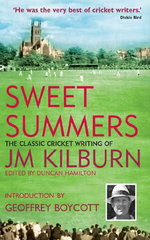Sweet Summers: The Classic Cricket Writing of JM Kilburn
David Taylor |Published: 2008
Pages: 352
Author: Hamilton, Duncan (editor)
Publisher: Great Northern Books
Rating: 4 stars

My Dad was always the easiest member of the family to buy presents for, I thought. An avid reader who liked many sports, it was generally just a case of scanning the shelves of WH Smith or Waterstones for something I knew he didn’t have. When I started getting review copies of cricket books, or acquired them at my favourite bookstall at Canterbury, I’d often pass them on to him as well, but only those which I knew he’d like – Runs in the Memory, Class of ’59 – you get the idea I’m sure. This was one that I bought for him at Christmas 2009; it had been Wisden’s book of the year. I’m not sure if he ever got to read it, as we lost him the following April, but when I go home I’m often invited to take some books away with me, and this one caught my eye. So now, at least, this copy has been read.
I knew very little about Jim Kilburn, although I have one of his books, unsurprisingly a history of Yorkshire CCC. From Duncan Hamilton’s excellent preface I learned that he was born in Sheffield in 1909 and lived in the county for all of his 84 years. He was a decent club player in his twenties and thereafter, with the Yorkshire Post, a renowned writer on the cricket of his native county, respected by players and peers. “His writing spoke eloquently for him” writes Hamilton. “So eloquently, in fact, that Cardus wrote to the newspaper and said of Kilburn: ‘To my mind yours is the best cricket reporting today.’ It was the equivalent of a papal blessing.” He had no byline at that time, writing as ‘a Special Representative’. In time he got a byline, and, much more unusually, a photograph, and graduated to the front seat of the press box where his obituary in the Cricketer tells us he cut “a tall, impassive, magisterial figure puffing at his pipe.” He eschewed typewriters, writing every piece in a fountain pen, completing it as the last ball was bowled. Later he travelled to Australia to cover Ashes tours and counted Len Hutton among his friends. Players of later generations such as Geoff Boycott knew that they could speak to him without having their confidences betrayed.
So what was his writing like? In general much like the man himself; serious, elegant, economical. It’s not laugh a minute stuff – there’s none of the whimsy of a Robertson-Glasgow or a Gibson, or the poetic language of Cardus. At first glance it can all seem rather parochial, cosy and unthreatening. But Kilburn knew his stuff and he knew Yorkshire people, and he wasn’t afraid to give his opinion. Several pieces here see him concerned at what he saw as declining standards of behaviour on the field. He wasn’t a dyed-in-the-wool reactionary but it’s fair to say he was a conservative, at least with a small ‘c’. To me he comes into his own with some beautifully written pen portraits of players of his time: Hammond, Graveney, Statham and Trueman among others (and the 19th century all-rounder Alfred Mynn, who seems curiously out of place in this company). It’s clear that he didn’t see everything through White Rose tinted glasses – he was capable of appreciating good cricket from anyone. You won’t find much on Bradman or any overseas player though, as he usually only saw them when they came to Headingley or one of Yorkshire’s outgrounds.
Although I would like to have known when these pieces were written (there is a bibliography, but the books are undated) it is hard to fault this anthology, although it is clearly aimed at the more mature reader. Kilburn’s simple, elegant style – admired in a series of tributes at the back of the book – make his work easy to read as well as thought-provoking. Much of what he was saying fifty years ago holds true today.






Leave a comment